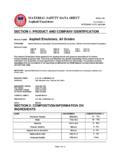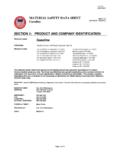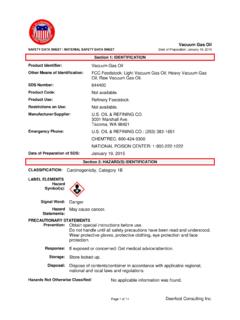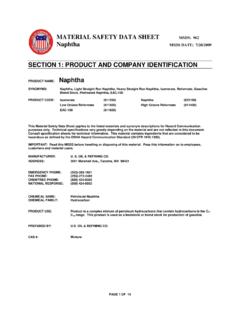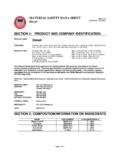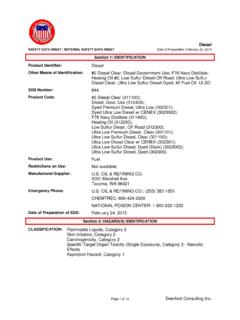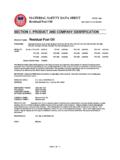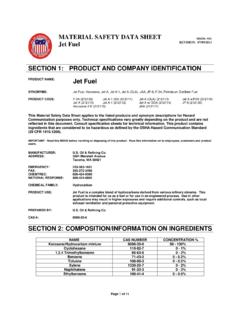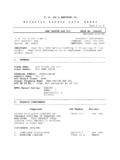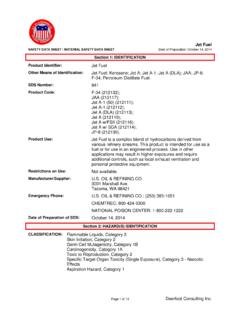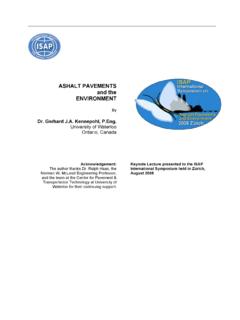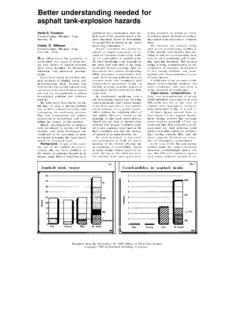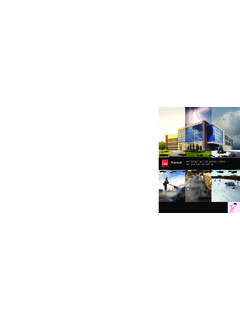Transcription of MATERIAL SAFETY DATA SHEET MSDS: 950 Asphalt Cement ...
1 Page 1 of 10 MATERIAL SAFETY data SHEET msds : 950 Asphalt Cement REVISION: 01/20/2012 SECTION 1: PRODUCT AND COMPANY IDENTIFICATION PRODUCT NAME: Asphalt Cement , All Grades SYNONYMS: Asphalt Cement (all grades), PG- Asphalt (all grades, Bituminous Cement ) PRODUCT CODE: AC-5 (512310) PG 58-28 (511413) PG 64-22 (511414) PG 52-28 (512311) PG 58-28 Plus (511423) PG 64-28 (513623) PG 52-34 (513627) PG 58-34 (513624) PG 70-22 (513626) PG 52-40 (512314) PG 58-40 (513625) PG 76-22 (513628) PG 58-22 (511412) PG 64-10 (511415) This MATERIAL SAFETY data SHEET applies to the listed products and synonym descriptions for Hazard Communication purposes only. Technical specifications vary greatly depending on the product and are not reflected in this document. Consult specification sheets for technical information.
2 This product contains ingredients that are considered to be hazardous as defined by the OSHA Hazard Communication Standard (29 CFR ). IMPORTANT: Read this msds before handling or disposing of this product. Pass this information on to employees, customers and product users. MANUFACTURER: Oil & Refining Co. ADDRESS: 3001 Marshall Avenue Tacoma, WA 98421 EMERGENCY: 253-383-1651 FAX: 253-272-2495 CHEMTREC: 800-424-9300 NATIONAL RESPONSE: 800-424-8802 CHEMICAL FAMILY: Hydrocarbon PREPARED BY: Oil & Refining Co.
3 CAS #: 8008-42-4 SECTION 2: COMPOSITION/INFORMATION ON INGREDIENTS NAME CAS NUMBERCONCENTRATION %Petroleum Asphalt 8052-42-485 100% Polymer Additive Mixture0 15% Anti-Strip Additive Mixture0 Hydrogen Sulfide 7783-06-04 Trace Page 2 of 10 SECTION 3: HAZARDS IDENTIFICATION Warning! MATERIAL is normally shipped at elevated temperatures and can cause severe eye and skin burns. Water contact can cause a violent eruption of hot Asphalt . PHYSICAL STATE: Semi-solid, Solid at ambient temperature COLOR: Black ODOR: Asphaltic ROUTES OF ENTRY: Dermal Contact, Eye Contact, Inhalation, Ingestion POTENTIAL HEALTH EFFECTS: EYES: Eye contact with hot product can cause severe burns.
4 Contact with this product at warm or ambient temperatures may cause eye irritation. SKIN: Skin contact with hot product can cause severe thermal burns. Prolonged or frequent contact with product at warm or ambient temperatures may cause skin irritation. INGESTION: Contact with hot product can cause thermal burns. Ingestion of this MATERIAL is expected to have a low order of acute toxicity. INHALATION: Vapors can irritate the eyes, nose, throat and/or lungs. Inhalation at high concentrations may cause headaches, nausea, dizziness, unconsciousness or death. Significant concentrations of hydrogen sulfide gas can be present in the vapor space of storage tanks and transport compartments. Exposure to high concentrations of hydrogen sulfide can cause unconsciousness and death. MEDICAL CONDITIONS GENERALLY AGGRAVATED BY EXPOSURE: Skin, eye and respiratory disorders may be aggravated by exposure to this product.
5 OVER-EXPOSURE SIGNS/SYMPTOMS: Inhalation of high concentrations may cause eye and respiratory irritation, headaches, dizziness, nausea, unconsciousness and possibly death. Prolonged or repeated contact with product at warm or near ambient temperature may cause skin irritation. Skin contact with hot product may cause thermal burns. Prolonged or repeated contact with this product at warm or ambient temperatures may cause skin irritation and dermatitis; however, based on human experience this product is judged to be neither corrosive nor an irritant by OSHA criteria. Eye contact may cause thermal burns or eye irritation. See toxicological information (section 11) Page 3 of 10 SECTION 4: FIRST AID MEASURES EYES: For contact with molten MATERIAL , flush eyes with clean low-pressure water for a minimum of 15 minutes.
6 Seek immediate medical care. SKIN: For contact with hot molten MATERIAL , cool skin by quenching with large amounts of cool water. Do not attempt to remove solidified MATERIAL from the skin, this may cause further skin/tissue damage. For skin contact with product at ambient temperatures, remove contaminated clothing. Wipe excess product off. Wash affected area with a waterless cleanser followed by soap and water. Mineral oil may be used to soften the product to aid the removal process. Seek medical attention if pain or irritation persists. INGESTION: Ingestion is not likely. If it occurs, do not induce vomiting. If large amounts are swallowed, seek medical attention. INHALATION: If affected, move person to fresh air. Administer oxygen or administer CPR (cardiopulmonary resuscitation) for respiratory distress and seek prompt medical attention.
7 If symptoms or irritation occur, seek prompt medical attention. NOTES TO PHYSICIANS OR FIRST AID PROVIDERS: Immerse skin covered with hot MATERIAL in cool water to limit tissue damage and prevent spread of liquid product. Recommended practice is to not attempt to remove hot MATERIAL . Allow the solidified MATERIAL to remain in place until cooled and allow MATERIAL to naturally fall off. If removal is necessary, mineral oil may be used to assist in minimizing skin loss when removing the solidified MATERIAL . Page 4 of 10 SECTION 5: FIRE-FIGHTING MEASURES FLAMMABILTY OF THE PRODUCT: NFPA Class IIIB combustible MATERIAL Flammable limits in air (% by volume) LOWER: Not Determined UPPER: Not Determined FLASH POINT: >316 C (600 F) COC AUTOIGNITION TEMPERATURE: Not Determined PRODUCTS OF COMBUSTION: Carbon dioxide, carbon monoxide, sulfur oxides, hydrogen sulfide, smoke, fumes and unburned hydrocarbons.
8 FIRE-FIGHTING MEDIA AND INSTRUCTIONS: Use dry chemical, foam, carbon dioxide or water fog. Water or foam may cause frothing and must be applied carefully to avoid frothing. Use water to keep fire exposed containers cool. Minimize breathing of vapors, fumes or decomposition materials. Collect contaminated fire-fighting water separately. Do not allow liquid runoff to enter sewers or public waters. SPECIAL FIRE FIGHTING EQUIPMENT: Fire-fighters should wear appropriate protective equipment and self-contained breathing apparatus (SCBA) with a full face-piece operated in positive pressure mode. Cool tanks and containers exposed to fire with water UNUSUAL FIRE & EXPLOSION HAZARDS: When heated above the flash point, this MATERIAL will release flammable vapors which if exposed to a source of ignition can burn or be explosive in confined spaces.
9 Mists or sprays may be flammable at temperatures below the normal flash point. Keep away from open flame. Use of water or foam on product above 212oF can cause product to expand with explosive force. Page 5 of 10 SECTION 6: ACCIDENTAL RELEASE MEASURES PERSONAL PRECAUTIONS: Immediately contact emergency personnel. Eliminate all ignition sources. Keep unnecessary personnel away. Use suitable protective equipment (section 8). Do not touch or walk through spilled MATERIAL . ENVIRONMENTAL PRECAUTIONS: Avoid dispersal of spilled MATERIAL and runoff and contact with soil, waterways, drains and sewers. If facility or operation has an "oil or hazardous substance contingency plan", activate its procedures. Stay upwind and away from spill. Wear appropriate protective equipment including respiratory protection as conditions warrant.
10 Do not enter or stay in area unless monitoring indicates that it is safe to do so. Isolate hazard area and restrict entry to emergency crew. Contain spill in smallest possible area. Prevent spilled MATERIAL from entering sewers, storm drains, other unauthorized treatment or drainage systems and natural waterways. Contact fire authorities and appropriate federal, state and local agencies. If spill of any amount is made into or upon navigable waters, the contiguous zone, or adjoining shorelines, contact the National Response Center at 800-424-8802. For highway or railway spills, contact Chemtrec at 800-424-9300. METHODS FOR CLEANING UP: Land Spill: Shovel and dispose of with an appropriate disposal facility in accordance with local, state and federal regulations. Water Spill: Depending on density, asphalts tend to float or sink.
